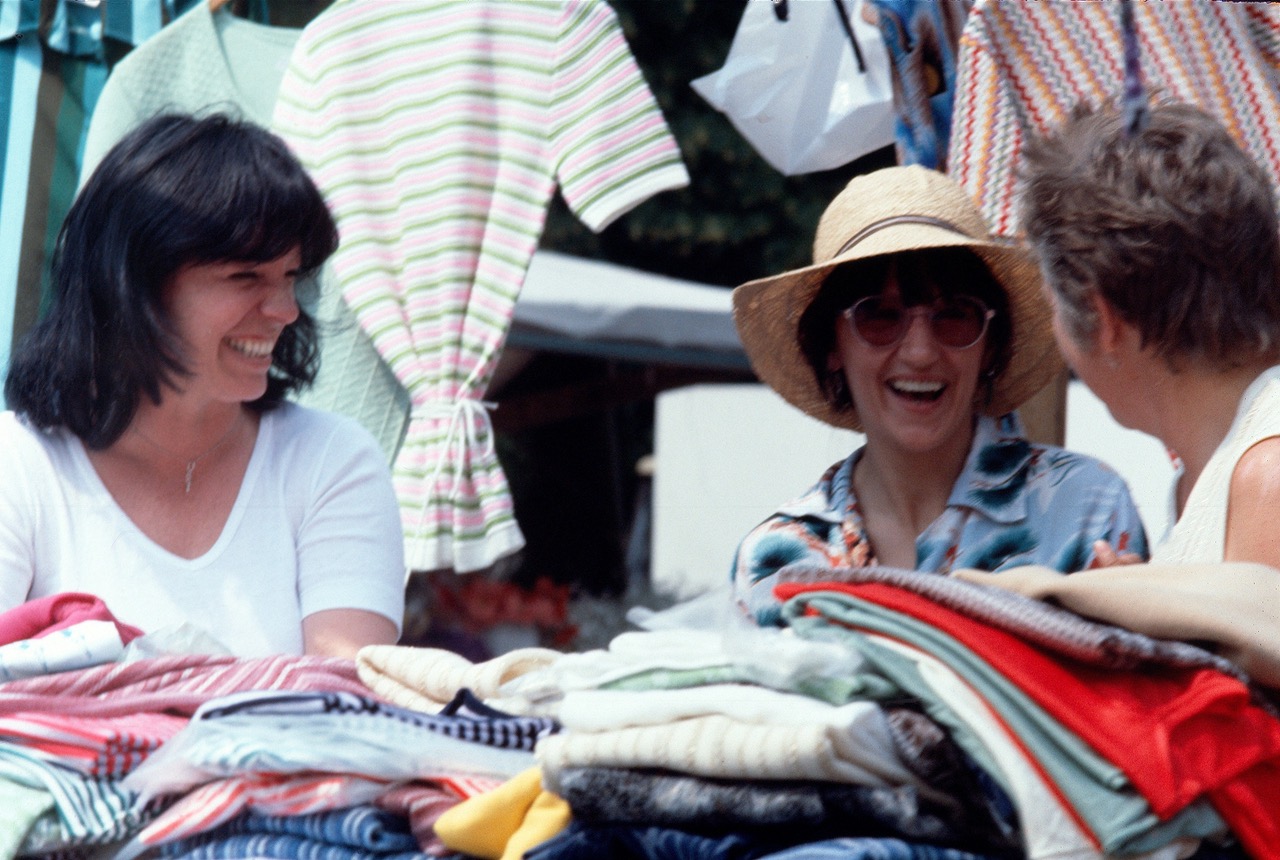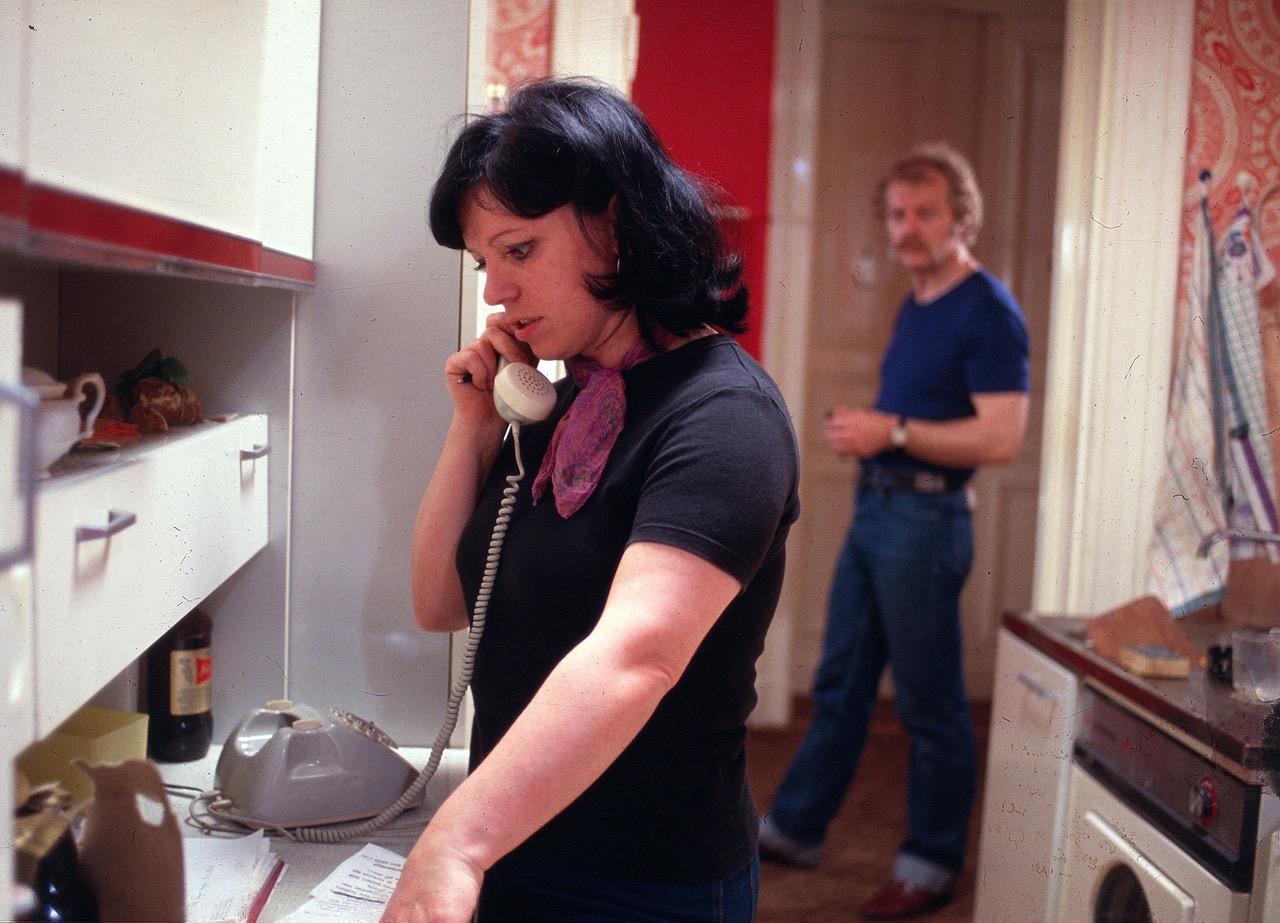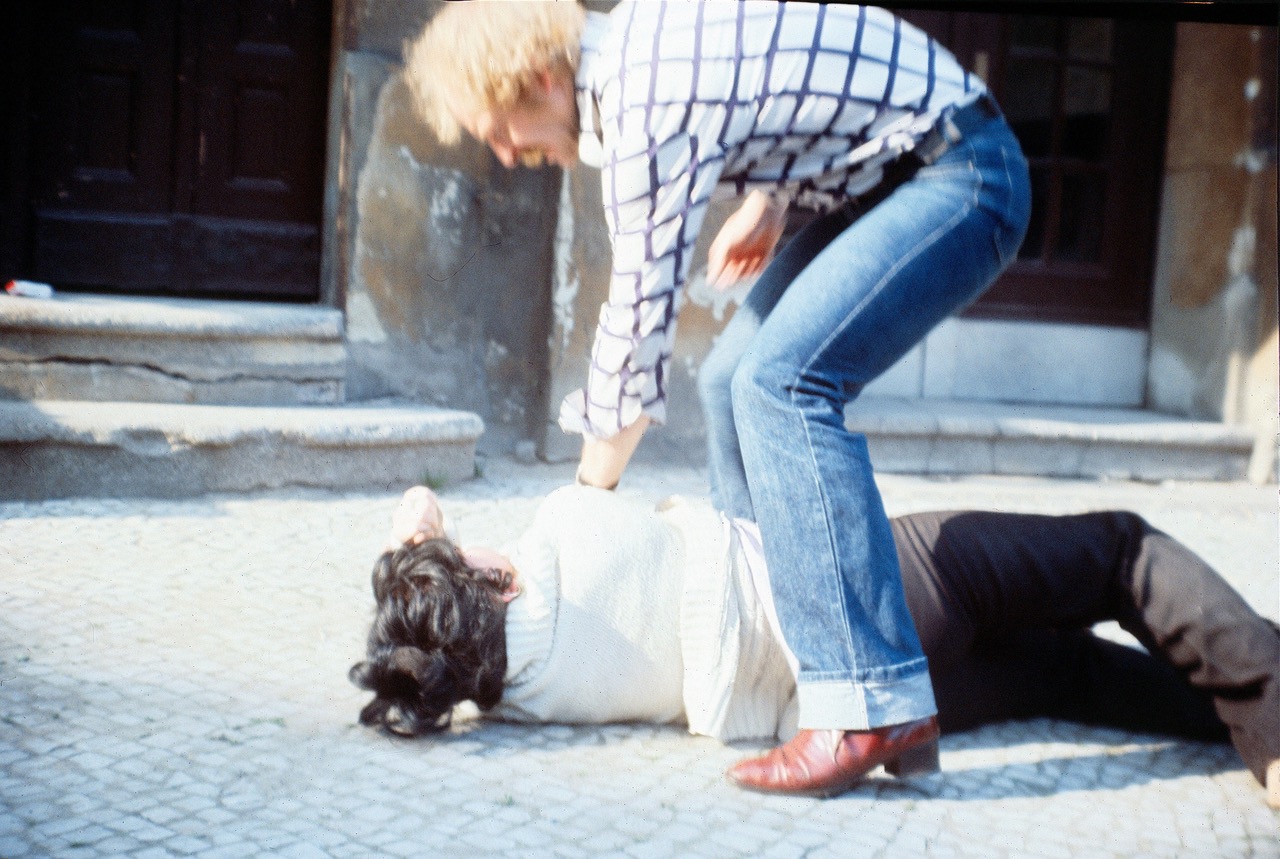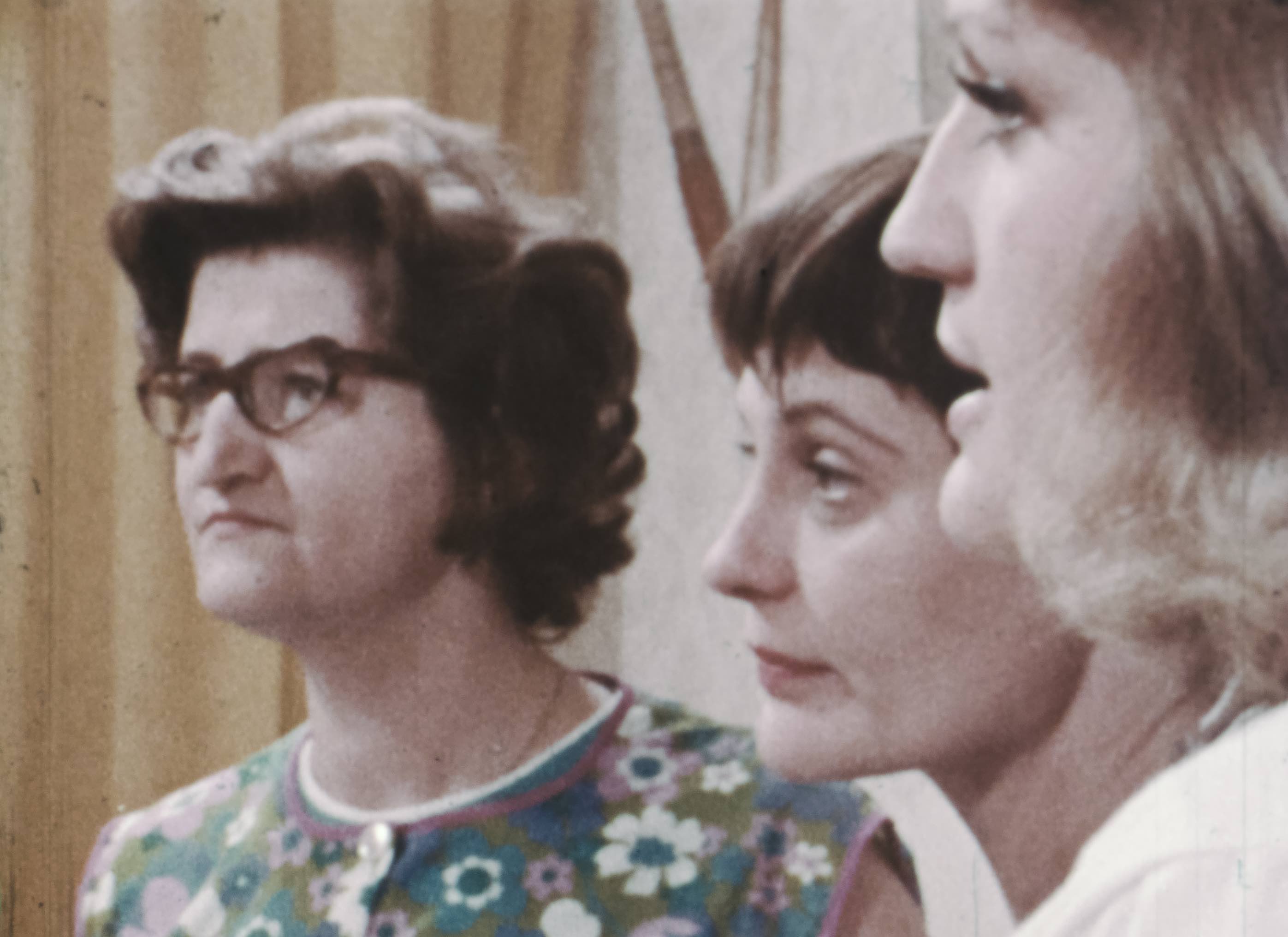Interviews with Cristina Perincioli

Women’s Movement art
by Marc Silberman
Filmography
Born in Switzerland, 1946, Perincioli began with experimental films; she studied at the German Academy for Film and Television in Berlin from 1968-1971. Active in the Newsreel Collective at the Film Academy, she taught at the Berlin Academy of Fine Arts 1973-1974. In 1972, she helped establish the Lesbian Action Center and the Women’s Center in Berlin. In 1979, she tried in vain to get money for a television documentary on the nuclear accident at Three Mile Island and its psychological effect; instead, she published her interviews in a book. She has made, with the Newsreel Collective, numerous documentaries on student revolts, tenants’ struggles, and women’s issues.
1971: Für Frauen. 1. Kapitel [For Women: Chapter 1] 45 min, 16mm, color, dist: Zentral Film (Hamburg). As four saleswomen at a supermarket strike for equal pay, they discover their solidarity as women and the interrelation of their home life and work.
1975: Anna und Edith 80 min., 16mm, color, dist: AG Kino (Hamburg). A group of female employees struggling for better working conditions are both frightened and encouraged by a lesbian relationship between two of them. Perincioli wrote the script together with Cillie Rentmeister. But the television producer fired her as director for not being impartial enough and then replaced her with a male director.
1978: Die Macht der Männer ist die Geduld der Frauen [The Power of Men is the Patience of Women] 76 min., 16mm, color, dist: Basis Film (Berlin). A fictionalized documentary presents the problem of battered wives and the psychological and social obstacles they face. Women in a battered wives’ shelter help each other and finally start a new living collective.
*
I have constructed narratives to awaken the viewer’s emotions, feelings of anger and joy. These emotions have a power that can be tapped and directed so that people become actively involved in changing themselves or their world. My films’ upbeat endings represent the collective wish of those involved to show that things can work out. It’s not to give directions for a mass movement nor establish models but rather to create an atmosphere of hope and courage.
I wrote the script for Die Macht der Männer, as I did for my first film Für Frauen. 1. Kapitel, according to the experience lived by the women in the film. For me to work this way, the people whose story is “exploited” for the film must themselves support the film which is ultimately made. In the case of Die Macht der Männer, a collective from the Berlin Home for Battered Women contacted me and said:
“Great. We want to participate. It’s extremely important that what we lived through get publicity. Besides, we have time now and want to get involved in something new.”
They wanted a film that would correspond to their ideas. They did not simply acquiesce to my plans. I didn’t approach them and say: “Tell me your story and I’ll make a film out of it.” Rather, we all shared a common motivation for producing this film.
Die Macht der Männer ist die Geduld der Frauen had 3.8 million television viewers. That is a prime rating for a film after 10 P.M.. Violence in marriages touches and interests all social classes. Moreover, we portrayed the issue in an easily understandable, conventional way so that people would still want to watch something about it after a day at work. I think it’s important to create a dramatic film if we choose a socially controversial issue. Otherwise an in-group watches it and not those people for whom considering that issue is really new. On the other hand, conventional German television form bores me. My camerawoman and I would have preferred an “observing camera”, such as we used during the video filming. After prior discussions of each scene, women acted out rather freely while we taped in a documentary style. But if you work this way, you can’t expect to save every foot of film, and you face the risk that the actors won’t deliver every day. We, however, had to plan everything down to a T. We divided each scene into individual camera shots. Since we received only one-fifth of the money that a network normally invests in this length television film, then you can imagine the limits of our “aesthetic freedom.” Aesthetic experiments cost money if you have to meet television standards at the same time. For example, we could have cut the budget by filming in black and white, but proud color TV-owners will readily switch channels if a black and white program appears.
Of 40 reviews of the film, only four were bad. All reviewers agreed: “This is a real social problem, and the film does not just depict men negative1y.” So the critics were happy. I’d also like to make a film where all women are not pitied or oppressed but strong, independent, and happy, too, but that’d probably displease half of these same critics.
I saw Chantal Akerman’s Jeanne Dielman and thought it boring, maybe too intellectual. Within three minutes I could see what was coming, why it would be so slow. But then I had to sit through it. There was nothing new, damn it, except the pace. This idea in itself could have provided one scene, but not the basis of a 90-minute film. We used to shoot the assembly line work to show how boring it is, but that footage would not interest workers or make them angry about working conditions.
If you want a housewife to wake up and say, “What the hell am I doing?” you first have to give her a glimpse of the possibility of change. Only then can a woman afford to realize how shitty her own position is. If you just show once more how boring her day is, then she will tune out.
When I see what other German women are filming, I find they really avoid the politically controversial and important topics. They produce films hardly distinguishable from typical male films except they use a woman as a main character. Their films may be beautiful but do not generate useful public discussions. I’d criticize my women colleagues for not exploiting the space in the media that the women’s movement has created for them. These women filmmakers could be helping the movement, not just with propaganda films. Instead they exploit this freed-up space to create their own cinematic career, just like the men.

Interview with Perincioli, November 1980
by Gretchen Elsner-Sommer
The following interview with Cristina Perincioli was taped in November 1980 at the Conference on Feminist Film Criticism at Northwestern University. Present at the interview were Margaret Morse and Jacquelin Levitin. Screened at the conference was Perincioli’s Die Macht der Männer ist die Geduld der Frauen.
Gretchen Elsner-Sommer: Could you tell us a little about your background?
Cristina Perincioli: I served one and one-half years in the Swiss army, not as a soldier, but as an employee in the film department, where I saw all those nuclear warfare films shown to the soldiers. We in the office saw all the films, but the army showed the soldiers only one, telling them that a nuclear attack was not so very dangerous.
In my Swiss, artistic family, avant-garde and pop art had surrounded me, so Brakhage-style underground filmmaking was my next step. Content then meant nothing to me, only the picture and its atmosphere. I played with colors and lines and constructed film like a piece of music.
In 1968 I came to Berlin at age 22 from the Swiss countryside, where nothing was going on, into the bustle of Berlin’s student rebellions. In Berlin, the students told me just to be quiet because I had no political consciousness. A friend suggested that I read Herbert Marcuse, which I did, and it let me understand art’s importance for me. I saw that art could be a substitute for life or happiness and understood this well through my mother’s life. She had been into art her whole life but somehow had been cheated by life. Perhaps we should try to make life better instead of making more and more beautiful, refined, and complicated substitutes for life.
I began to make films collectively in a documentary group that made films about the student rebellions and about people’s struggles, films which would have no possibility of getting on television.
Ironically at the Berlin Film School in 1968, I ended up not making films at all but rather became very involved in politics and in the women’s movement. I tried to build the women’s movement by doing a lot of historical research. And I turned to radio to publicize information about battered wives. I worked with a lot of groups and had a lot of different jobs. For one year I ran a restaurant.
In 1975, I was contacted to make a television film on lesbian relations. The script I wrote with a friend of mine would have made a right-on fighting lesbian film. The producers kicked me out and filled the story with a lot of strange jokes. Even so, lesbians loved it because they were grateful to have even something clumsy. The script was very radical, but somehow you don’t believe it because the actresses just spoke their parts. Also, the actresses in the film were not lesbians and were afraid to touch each other.
How was the screenplay for the battered wives film developed?
I had interviewed a lot of battered women for radio and for a book I had done on the subject. Then this group of three women (battered wives) contacted me – Addi (who became the film’s main character) and the two women that she lives with (who also appear in the film). They were already a cohesive group when they came to me and so were not dependent on me. Most women find themselves isolated who have this problem and would find it a very heavy thing to make a movie about their own story. But because of their togetherness these women could handle it. The final story then is mostly Addi’s story, but it contains what I had heard from all those other women.
Could you give us some specific examples showing us how you improvised with the actors?
I did not know how the women talked to each other in the shelter, for example. They acted it out for me, and I wrote the best parts into the script, which they then memorized. They were still free to improvise. And for the last sequence, we just talked about what these women were really planning to do after making this film. I wrote a script from that and then we shot it.
The film really shows the fine relation you have with the women and your sense of community working with them. It’s there right from the first shot with the women vendors laughing in the market place. There is a sense of togetherness and tenderness among those women, who are making each other laugh as the world goes on busily all around them.
Do you plan as a matter of principle to work with non-actors?
Yes. We had actors in the film, with whom I had great trouble. But with these three women, it was their film, and they were so good I couldn’t have told them how to act. They knew a lot of things naturally about conveying the problems of battered wives that I could never have told them.
To actors you are always saying things like, “Now, don’t speak so loud.” You always have to tell them that, because they get paid for making loud noises and extravagant gestures and so overact. Also, some actors have to be mothered all the time. You have to take care of them not only during the shooting but also after, so they will be ready to act again the next day. Some actors always need to be built up. I can’t do that.
Did the women need to be encouraged? Did they need to be told, “That’s good”?
No, they could relate to the rest of the group and so they felt good about what they did. An actor played Max, Addi’s husband.
How did he feel about representing a battering husband?
He made a lot of effort, yet I don’t know how much he understood his role. The reason that I wouldn’t want to work again with actors is because they have so little to offer from inside. It’s like paper compared to what nonactors have to give.
Furthermore, the crew was nearly all women and everybody liked each other. In fact, they are all still friends, even now. It was always relaxed.

Could you talk about the violence in the film and how you decided to portray it, and why?
We wanted people to understand what it was like for a woman to be beaten, but we didn’t want to show violence as stimulating or exciting to watch. We start the film with a scene of violence where Addi’s husband follows her into the street, pushes her down, and beats her. He actually kicks her in the stomach again and again.
The next time we refer to violence is in a long take of Addi in the hospital waiting for the doctor. Over this long take, you hear a cool medical report narrating the results of Addi’s beating. Not only does this downplay visua1 depictions of violence, it also shows how institutions react by making women into a mere piece of paper, a clear medical report that does not show how women hurt.
So the first violent scene really stands for all the violence. You can’t bear that violence all the time, but we had to show it once as it really is, and not as it’s frequently seen on television and in films. We see a lot of rapes and slapped women’s faces on television, but we are not always aware of it because somehow there it looks normal that a man should react that way. television makes you feel that this guy couldn’t do anything else but that. We wanted to show the ugliness and cruelty of real violence to women.
How did you attempt to do this?
Rape is mostly very short in films and somehow elegant. We show how it can be very long as a man keeps on kicking, slapping, and punching a woman. This sense of on-goingness makes a difference and feels very ugly. Especially in a normal movie, you would never see a man kick a woman in the stomach for such a long time. The film shows action that men would be ashamed of. There is nothing chivalrous or manly about what happens. It is just plain ugly.
In the film, Addi realizes that part of her husband’s problem stems from the fact that he was beaten as a child and the fear that he has that she will leave him. The film is sensitive to Max’s problem, too, and shows some understanding of it.
What was Addi’s husband’s reaction to the film?
We were all very afraid of what his reaction would be. We sent Addi out of town for a few days when the film was first shown on television. Even the neighborhood bar, which appears in the film, closed down for the evening, because Max often drinks there. They were afraid that he might cause problems. However, he was very calm.
Another woman did come to live with him and he beat her too. Finally, she left him. When this woman left him, he couldn’t stand it. With men who beat their wives, after the women leave them, they usually fall apart. Max couldn’t function. He lost his job, then his car. He felt he had nothing, no strength, and committed suicide.
It is a very sad story. These men don’t know how to ask for help, nor even see that they need help.
Why is the camera so often distant from the action?
I felt no need to go in close to show people’s noses. In these depressing scenes, the camera does not move at all, as if the weight of the scene expresses itself in the weight of the camera. In setting up the shots, it depended very much on how Addi felt as to how we’d move the camera. In all the scenes where she is a little strong and happy, we hand held the camera. All the scenes where she is depressed were filmed on a tripod. Although we had sensed it while shooting, we did not see that dichotomy until later.
How do you feel about this film in relation to your other films?
I like this one best because the reaction to it has been best. However, we had a long list of issues we wanted to treat, and from those we made the film. If we had had the whole film in mind and not just episodes, perhaps we would have been more aware of the dramatic line. It feels clumsy now. When I first made films, I was not interested in content, just atmosphere with lines and color. Now this film seems totally the opposite. We didn’t care about atmosphere but just wanted to show information, and it feels like a heap of information, one item after another.
Yes, but that makes it Brechtian. A seamless attachment of narrative continuity would work against many of the distancing effects that you have achieved. The discontinuity allows the beatings to be seen as historical and social phenomena and not simply as an unfortunate story. Do you want to make political films in the Hollywood narrative style?
No, but we often show a dramatic situation here, and then it is over, with no build-up or connection between some scenes.
What would you have liked to do differently?
If we had a little more money and a little more time, we would have shot it more like a documentary. When we worked with video the actresses did a lot of improvisation, but when we worked with the cameras we had to be more exact. For instance, take the first scene in the kitchen. Max comes home from work with a present for the child. He goes and wakes up the child. The child cries. The man gets hungry and more and more angry, until the point where Addi leaves. We shot this scene many times in video, and the last time we shot it, it was so beautiful. We just ran after them with the video camera, in the kitchen and out, with beautiful natural light streaming from the windows. You couldn’t see every detail. It wasn’t straight dialogue either – you couldn’t understand every word. I found it more interesting than what we finally shot in film because the viewer has to be more aware of what is going on. What we did finally looks very much like television with every corner lit and everything told to the audience.
Why did you choose to make a narrative film? Is this a form you always want to work with?
Sometimes I’d like to do something very, very different. Here, an impressionistic film with a little of this and a little of that would not have worked. We were describing a strong woman’s struggle to escape from a kind of hell and we had to be precise. Now I am trying to find a way to pull together all the feelings that we have about our environmental crisis and nukes, all the fears people have and how this affects our lifestyles. Something artistic that people could understand could be done without narration because we all live in this world and we all have these fears and concerns. I’d like to capture that spirit in an impressionistic way, in a way people could relate to and say,
“Yes, that’s it. That’s the style. Yes, that’s hurting me.”
This way we could reach people on a level that they already recognize but teach them to see it more deeply. To be accessible to a large audience and make a point, one does not have to stick to narrative form.
Tell about your work with radio.
It’s not so important to make a film as to reach people. I can pick up my Sony and work for radio stations. Then I not only get paid but also reach a lot of people. If there is something I want to say or if something happens, I can very quickly tell people about it that way on a huge scale. If I were to pick up my camera, maybe the work would be finished in a few months or in a year. I’d have trouble scraping the money together. And then it would be shown only in groups that already knew about the situation.
Here in the United States, I’ve done interviews with people from Harrisburg and with American Indian women. In radio, you do not face as much supervision or control as you do filming for television. Somehow the people who control radio don’t think of it as very important, because I can say things there that I cannot on television. Radio is popular in Germany. A lot of people play it all the time, like people in the United States turn on television during the day. In Germany, television is only broadcast from 6 p.m. to 11 or 12 p.m.
Also, I just did a book about Harrisburg and Three Mile Island and put it out with a big publishing house. They have an enormous distribution, so I will reach a lot more people than I could have with a film. 70,000 copies sold in the first weeks. Not only was I effective, but also I got paid well for the work that I did.
Could you talk about the different women making films in Germany today and the differences between you and other German women filmmakers?
Women making films in Germany are not necessarily feminist. Helke Sander is a feminist and an old Movement fighter who did a lot of films that could be used immediately in the Movement, such as a brilliant film on contraceptives.
When I got together with a group of other German women filmmakers in Los Angeles, we all had great difficulty in liking each other’s work.
Helga Reidemeister was the most political, and so we had something in common.
For most of these women, film represents a profession. They find it important to make a beautiful work and get famous. I want to make films but also to change things, maybe by making a film, maybe by doing something else. Helga is like that too, but you’ll find few others who want to fight first, before making beautiful movies. I criticize that very much.
I get the feeling that the feminist movement fought in many areas such as television and film, so that women could get more respect, opportunities, and money. Many women now taking advantage of these opportunities don’t come from the women’s movement but get all the places that the women’s movement fought for. They make films by women but do not contribute to the women’s movement. They may make good films, I don’t deny that, but they do not contribute to the kind of discussion that would help us move a little further.

Image (1), (2) & (3) from Die Macht der Männer ist die Geduld der Frauen (Cristina Perincioli, 1978) | Courtesy of Deutsche Kinemathek
Image (4) from Für Frauen. 1. Kapitel (Cristina Perincioli, 1971) | Courtesy of Deutsche Kinemathek
This text was originally published in Jump Cut, no. 29 (February 1984): 52-53.
Many thanks to Julia Lesage and Marc Silberman.
This work is licensed under a Creative Commons Attribution-NonCommercial-NoDerivs 2.5 License.

